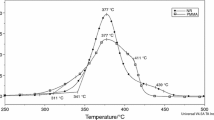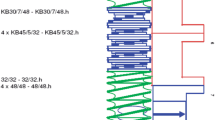Abstract
Compatibility is a key factor in formulation of polymeric compounds. Having sufficient data about solubility of components may help to create novel engineered materials. Solubility parameter has been used as a tool for predicting the compatibility of materials. In this study, the solubility parameter of natural rubber and styrene–butadiene rubber is determined through inverse gas chromatography. The 3D solubility parameter sphere for each rubber has been depicted using three components of the Hansen solubility parameter. In addition, the reliability of the procedure has been confirmed through scanning electron microscope (SEM) micrographs and Fourier-transform infrared spectroscopy (FTIR-ATR) spectra of samples. Results demonstrate NR and SBR solubility parameters to be 23.58 and 21.98 (J/cm3)0.5 at room temperature. Also, this study aimed to verify if the inverse gas chromatography method is a reliable method to be used in polymer industries as a prediction tool before compounding. Finally, results confirmed that inverse gas chromatography is a promising method in the field of rubbers.
Graphic abstract








Similar content being viewed by others
References
Adamska K, Voelkel A, Berlińska A (2016) The solubility parameter for biomedical polymers—application of inverse gas chromatography. J Pharm Biomed Anal 127:202–206
Anderson JL, Pino V, Hagberg EC, Sheares VV, Armstrong DW (2003) Surfactant solvation effects and micelle formation in ionic liquids. Chem Commun 19:2444–2445
Bardavid S, Schulz P, Arancibia E (2003) Solubility parameter determination of cationic surfactants by inverse GC. Chromatographia 57(7–8):529
Barton AF (2017) CRC handbook of solubility parameters and other cohesion parameters. Routledge, London
Basivi PK, Sreekanth T, Sivalingam R, Thota C, Pasupuleti VR (2019) Surface characterization and London dispersive surface free energy of functionalized single-walled carbon nanotubes with a blend of polytetrafluoroethylene by inverse gas chromatography. Surf Interface Anal 51:516–524
Burke J (1984) Solubility parameters: theory and application. The American Institute for Conservation 3
DiPaola-Baranyi G, Braun J-M, Guillet J (1978) Partial molar heats of mixing of small molecules with polymers by gas chromatography. Macromolecules 11(1):224–227
DiPaola-Baranyi G, Guillet J (1978) Estimation of polymer solubility parameters by gas chromatography. Macromolecules 11(1):228–235
Djuris J, Nikolakakis I, Ibric S, Djuric Z, Kachrimanis K (2013) Preparation of carbamazepine–Soluplus® solid dispersions by hot-melt extrusion, and prediction of drug–polymer miscibility by thermodynamic model fitting. Eur J Pharm Biopharm 84(1):228–237
Farshchi N, Abbasian A, Larijani K (2018) Assessment of the thermodynamic properties of dl-p-mentha-1, 8-diene, 4-isopropyl-1-methylcyclohexene (dl-limonene) by inverse gas chromatography (IGC). J Chromatogr Sci 56(8):671–678
Fedors RF (1974) A method for estimating both the solubility parameters and molar volumes of liquids. Polym Eng Sci 14(2):147–154
Ferguson A, Caffrey IT, Backes C, Coleman JN, Bergin SD (2016) Differentiating defect and basal plane contributions to the surface energy of graphite using inverse gas chromatography. Chem Mater 28(17):6355–6366
Gupta J, Nunes C, Vyas S, Jonnalagadda S (2011) Prediction of solubility parameters and miscibility of pharmaceutical compounds by molecular dynamics simulations. J Phys Chem B 115(9):2014–2023
Huang J-C (2006) Anomalous solubility parameter and probe dependency of polymer–polymer interaction parameter in inverse gas chromatography. Eur Polymer J 42(5):1000–1007
Imbernon L, Oikonomou E, Norvez S, Leibler L (2015) Chemically crosslinked yet reprocessable epoxidized natural rubber via thermo-activated disulfide rearrangements. Polymer Chem 6(23):4271–4278
Jung HS, Kwon SH, Choi HJ, Jung JH, Kim YG (2016) Magnetic carbonyl iron/natural rubber composite elastomer and its magnetorheology. Compos Struct 136:106–112
Karakehya N, Bilgiç C (2016) Inverse gas chromatographic determination of the surface energy of PMMA and PMMA/organophilic montmorillonite nanocomposites. Surf Interface Anal 48(7):519–521
Marciniak A (2010) The solubility parameters of ionic liquids. Int J Mol Sci 11(5):1973–1990
Marsac PJ, Shamblin SL, Taylor LS (2006) Theoretical and practical approaches for prediction of drug–polymer miscibility and solubility. Pharm Res 23(10):2417
Meng F, Dave V, Chauhan H (2015) Qualitative and quantitative methods to determine miscibility in amorphous drug–polymer systems. Eur J Pharm Sci 77:106–111
Öztürk E, Ocak H, Cakar F, Karanlık G, Cankurtaran Ö, Bilgin-Eran B (2018) Investigation of thermodynamic properties of 4-decyloxybiphenyl-4′-carboxylic acid liquid crystal and preparation of polymer dispersed liquid crystal composite. J Mol Liq 265:24–30
Paul D, Barlow J (1984) A binary interaction model for miscibility of copolymers in blends. Polymer 25(4):487–494
Williams RD (2015) Particle engineering in pharmaceutical solids processing: surface energy considerations. Curr Pharm Des 21(19):2677–2694
Riedl B, Matuana LM (2015) Inverse gas chromatography of fibers and polymers. Encyclopedia of surface and colloid science. CRC Press, Boca Raton, pp 3352–3364
Thakral S, Thakral NK (2013) Prediction of drug–polymer miscibility through the use of solubility parameter based Flory–Huggins interaction parameter and the experimental validation: PEG as model polymer. J Pharm Sci 102(7):2254–2263
Voelkel A, Strzemiecka B, Milczewska K, Okulus Z (2015) Inverse gas chromatographic examination of polymer composites. Open Chem 13(1): 893–900
Xia Y, Chen J, Wu Z, Wang T, Li J (2015) Measurement of solubility thermodynamic and diffusion kinetic characteristic of solvents in PDMS by inverse gas chromatography. Eur Polymer J 73:259–267
Yao Z, Ge L, Ji X, Tang J, Xia M, Xi Y (2015) Surface properties studies of bivalve shell waste by the IGC technique: probing its significant potential application in the polymer industry. J Alloy Compd 621:389–395
Yu Y, Li K, Ma Y, Wei L (2013) Determination of the solubility parameter of organosolv lignin by inverse gas chromatography. Chin J Chromatogr 31(2):143–146
Author information
Authors and Affiliations
Corresponding author
Ethics declarations
Conflict of interest
Author Negin Farshchi declares that she has no conflict of interest. Author Ali Abbasian declares that he has no conflict of interest. Author Kambiz Larijani declares that he has no conflict of interest.
Ethical approval
This article does not contain any studies with human participants or animals performed by any of the authors.
Additional information
Publisher's Note
Springer Nature remains neutral with regard to jurisdictional claims in published maps and institutional affiliations.
Rights and permissions
About this article
Cite this article
Farshchi, N., Abbasian, A. & Larijani, K. Is Inverse Gas Chromatography (IGC) a Convenient Method to Determine Compatibility of Rubber Materials?. Chromatographia 82, 1709–1719 (2019). https://doi.org/10.1007/s10337-019-03791-0
Received:
Revised:
Accepted:
Published:
Issue Date:
DOI: https://doi.org/10.1007/s10337-019-03791-0




